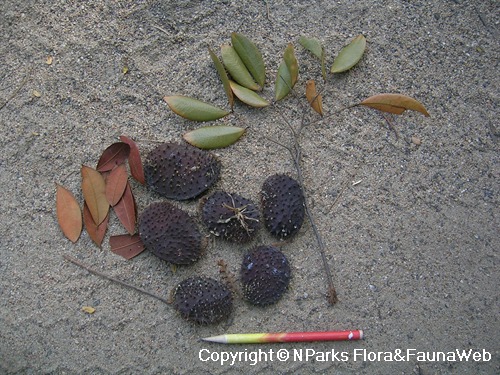_lowres.jpg)
Back
Sindora coriacea (Baker) Prain
| Family Name: | Fabaceae (Leguminosae) |
| Common Name: | Sepetir, Sepetir Licin, Sepetir Minyak |
Sindora coriacea is a critically endangered tree in Singapore that can reach up to 37 m tall. It bears fruit pods, which are typically unarmed or may have a few slightly raised warts on the outer surface. The tree produces timber prized for furniture, flooring, indoor construction and veneer, while its oil is used in paints, boat caulking, and as a source of illumination.
Name
Classifications and Characteristics
| Plant Division | Angiosperms (Flowering Seed Plants) |
|---|---|
| Plant Growth Form | Tree |
| Lifespan (in Singapore) | Perennial |
| Mode of Nutrition | Autotrophic |
| Maximum Height | 37 m |
Biogeography
| Native Distribution | Thailand, Peninsular Malaysia, Singapore, Sumatra and Borneo |
|---|---|
| Native Habitat | Terrestrial |
| Preferred Climate Zone | Tropical |
| Local Conservation Status | Native to Singapore (Critically Endangered (CR)) |
Description and Ethnobotany
| Growth Form | It is a tree, up to 37 m, with dark brown bark and may develop buttresses. |
|---|---|
| Foliage | The leaves are compound, measuring (2–) 5.5–11.5 cm long, and consist of 3–4 pairs of leaflets. The leaflet is elliptic, ovate, or broadly falcate, about 4.5–14.7 cm long and 2.1–8.1 cm wide. The leaflet tip is usually tapering (acuminate) and sometimes obtuse or slightly notched (emarginate), while the base is cuneate, rounded, or occasionally asymmetrical. The lower surface of mature leaflets is glabrous or sparsely hairy (puberulous) at the base, except the midrib, which is usually hairy (puberulous). Glands are present at the tip of the midrib on the lower surface, as well as on the thickened marginal vein near the leaflet base. The petiole is 2–4 (–5.5) cm long. |
| Flowers | The flowers occur in a branched cluster (panicle) at both terminal and axillary positions, measuring (12.5–) 16 – 38.5 cm long and 3 – 9 cm wide. Each flower has 4 sepals, greenish yellow on the outside and rusty velvety on the inside, and a single petal which forms a well-defined hood at the top, tapering to lower half with the edges inrolled at the sides that almost form a tube. The flower also contains 9 - 10 stamens with the two longest filaments green while the remaining filaments white. The ovary is semi-circular, densely hairy around the edges and glabrous in the centre. The style is glabrous and about 9.5 – 10.5 mm long. |
| Fruit | The fruit pod is elliptic, round to ovate, about 4.4 – 10 cm long and 3.3 – 6.2 cm wide, with a stipe and beak. The outer surface of the pod is usually unarmed or with a few slightly raised warts. At maturity, the pod turns dark reddish brown to black and split open to reveal 1 – 3 black seeds. Each seed, measuring about .9 – 2.5 cm long and 1.4 – 1.6 cm wide, is attached to a chestnut-brown aril which is about 1.4 – 2 cm long and 1.3 – 1.4 cm wide. |
| Habitat | It is found in rainforest, up to 300 m altitude. |
| Associated Fauna | Flowers are pollinated by insects. |
| Taxonomy | It is the parent plant of Sindora × changiensis L.M.Choo, Loo, W.F.Ang & K.Er |
| Etymology | The genus epithet refers to the latinised local name sindur. Specific epithet coriacea, in Latin, means leathery, referring to the texture of the leaflets. |
| Ethnobotanical Uses | Timber & Products: The timber is used for making furniture, indoor construction, flooring, and veneer. Its dark brown to black streaks give it an attractive appearance, especially for decorative veneer. The wood also produces an oil that has been traditionally used in paints, for caulking boats, and as a source of illumination. |
Fauna, Pollination and Dispersal
| Pollination Method(s) | Biotic (Fauna) |
|---|
Plant Care and Propagation
| Light Preference | Full Sun |
|---|---|
| Water Preference | Moderate Water |
| Plant Growth Rate | Moderate |
References
| References | Choo, L.M. and Ngo, K.M. (2020) A revision of the genus Sindora (Fabaceae, Detarioideae) in Peninsular Malaysia and Singapore. Gardens' Bulletin Singapore 72 (2): 233–254. Choo, L.M., Loo, A.H.B., Ang, W.F., Er, K.B.H. (2022) A natural hybrid of Sindora (Fabaceae, Detarioideae) from Singapore. PhytoKeys 190: 87–102. Ding, Hou. (2000). Leguminosae-Caesalpinioideae. In: Soepadmo, E. & Saw L.G. (eds) Tree Flora of Sabah Sarawak, vol. 3, pp. 119 – 180. Malaysia: Sabah Forestry Department, Forest Research Institute Malaysia, & Sarawak Forestry Department. Lemmens, R.H.M.J. and Soerianegara, I. (eds). (1993). Plant Resources of South-East Asia Volume 5 (1). Timber trees: Major commercial timbers. Indonesia: Prosea Foundation. 610 pages. |
|---|
Image Repository
Others
| Master ID | 2004 |
|---|---|
| Species ID | 3296 |
| Flora Disclaimer | The information in this website has been compiled from reliable sources, such as reference works on medicinal plants. It is not a substitute for medical advice or treatment and NParks does not purport to provide any medical advice. Readers should always consult his/her physician before using or consuming a plant for medicinal purposes. |

_lowres.jpg)
_lowres.jpg)
_lowres.jpg)
.jpg)
_lowres.jpg)
